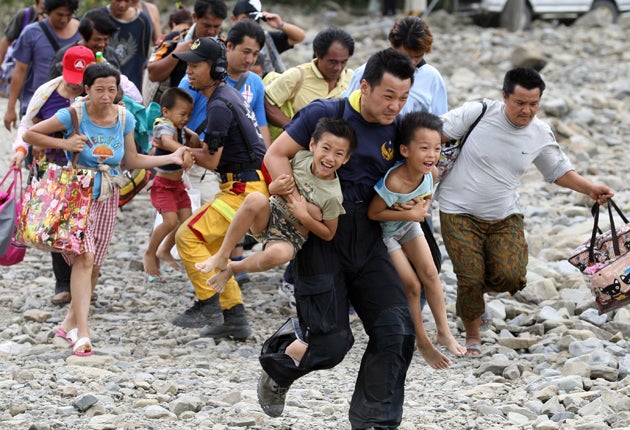As Taiwan typhoon clear-up begins, so do the questions
President is jeered on tour of disaster area as victims ask why he took so long to accept foreign aid

As Taiwan begins the painful process of recovery following last weekend's devastating typhoon, which left hundreds dead and missing, pressure is mounting on the country's President over his handling of the crisis.
President Ma Ying-jeou has been forced to apologise to survivors who say his government's rescue effort has been too slow. There have also been calls for a government reshuffle.
Yesterday he provided a new estimate of 500 deaths in the floods and mudslides unleashed by Typhoon Morakot. He gave the figure at a national security meeting – the first such emergency meeting Mr Ma has called since taking power 15 months ago. The official count of confirmed deaths still stood at 118.
Internal opposition has been further catalysed by Mr Ma having persistently declared that the country did not need foreign aid, only to subsequently perform an embarrassing U-turn. "I'm sorry," the beleaguered president said repeatedly as he visited a flood-ravaged Taoist temple and devastated orchards in the south-western county of Tainan earlier this week.
Arriving by helicopter at a relief centre in the town of Chishan, also in the south, he found himself jeered by angry locals. "We're busy here," they shouted. "Go and help the people, don't come here." At other stop-offs, protesters held banners saying: "The government is inept."
"The whole thing looks in disarray, in the public's opinion," Alex Chiang, a teacher of political science at the National Cheng Chi University in Taipei, told the Associated Press. "They were caught off-guard."
In the face of the strong criticism, the President called on rescue crews to step up their efforts yesterday, ordering the police force to add cadets to their post-disaster team and sending 10,000 more servicemen to the affected areas.
Although the government also announced an additional NT$3bn (£55m) in relief funds over the next two years, the momentum was against Mr Ma as a high-profile internet campaign asked the world for donations because – its organisers said – the government was doing nothing. President Ma has been forced to deny press reports that his government had refused US assistance.
Taipei has now accepted a relief donation of $250,000 (£150,000) from the American Institute in Taiwan. And rescuers who have been relying on under-powered helicopters to reach the worst-hit areas have now asked foreign governments for larger choppers capable of carrying earth-moving equipment and shelters. But the President's delayed acceptance of foreign help has come too late to avoid his handling of the disaster having an impact on forthcoming city and county elections, in which support for his Kuomintang Nationalist Party is expected to fall.
Premier Liu Chao-shiuan has avoided addressing the volte-face, focussing instead on having government agencies draw up a list of what help they need. Typhoon Morakot tore through Taiwan over two days, leaving nearly two thirds of central and southern Taiwan under waters over five metres deep in many places.
It hit a part of the country where Mr Ma has never been popular, even when he was swept to power by a large margin in March 2008, after his arch-rival Chen Shui-bian, currently in jail facing corruption charges, stepped down. The south of the country remains the power base of Mr Chen's Democratic People's Party, and their supporters have been visible wherever the Harvard-educated Mr Ma has gone in the typhoon zone.
Typhoon Morakot destroyed the homes of 7,000 people and caused agricultural and property damage in excess of NT$50bn. President Ma called it the most severe damage to the island in more than 50 years. "While the rescue operation is still going on, we have started rehabilitation and reconstruction work, which is just as pressing as relief efforts but might be even more difficult and cumbersome," he said.
So far, 15,400 villagers have been ferried to safety, and rescuers are working to save another 1,900 people still stuck. Mr Ma said the new estimated death toll includes about 380 people feared buried in the debris of a landslide in Hsiao Lin, the hardest-hit village.
The military finally opened a road to Hsiao Lin yesterday, but authorities have given up hope of finding anyone alive under the tons of mud that now cover the village. Kaohsiung county chief Yang Chiu-hsing said that instead of digging into some 170 mud-buried homes, a memorial park will be built on the site.
Subscribe to Independent Premium to bookmark this article
Want to bookmark your favourite articles and stories to read or reference later? Start your Independent Premium subscription today.

Join our commenting forum
Join thought-provoking conversations, follow other Independent readers and see their replies